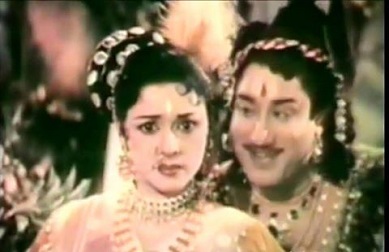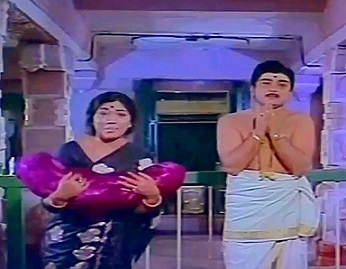Colour films in Tamil
| Line 7: | Line 7: | ||
[[File: veereng1.png|'' Veerapandiya Kattabomman '': the title card in English is silent about the colour film used|frame|left|500px]] | [[File: veereng1.png|'' Veerapandiya Kattabomman '': the title card in English is silent about the colour film used|frame|left|500px]] | ||
[[File: veertamil1.png|'' Veerapandiya Kattabomman '' (1959/ Tamil)<br/> The rich colours of all three stills from '' Veerapandiya Kattabomman '' on this page do suggest Technicolor|frame|left|500px]] | [[File: veertamil1.png|'' Veerapandiya Kattabomman '' (1959/ Tamil)<br/> The rich colours of all three stills from '' Veerapandiya Kattabomman '' on this page do suggest Technicolor|frame|left|500px]] | ||
| + | [[File: Veerapandiya Kattabomman Pogathey Pogathey En Kanavaa.jpg| ''' Veerapandiya Kattabomman:''' a frame from the song ''Pogathey Pogathey En Kanavaa '' <br/> This two-part image shows the stark difference between ''prints in '' Geva Color (left) and ''prints in '' Technicolor (right). The colours of two freeze-frames from the same song reveal what a big difference the choice of the colour positive film made. <br/> On the left, the heroine (Padmini) is seen wearing a dark pink blouse with a light green sari. On the right, the heroine wears a red blouse with a dark green sari. Red got reduced to pink and dark green to light green during the transition to Geva Color. <br/> Frames assembled by Mr Lourdes. |frame|500px]] | ||
| + | [[File: Veerapandiya Kattabomman GevaColor.jpg| Mr Lourdes has settled the controversy about ''Veerapandiya Kattabomman’s '' negative and positive films decisively with this poster of the film. <br/> The poster clearly states (underlined in red) that ''Veerapandiya Kattabomman '' was shot in GevaColor |frame|500px]] | ||
| + | |||
[[File: Sri Valli1.jpg| ''Sri Valli '' (1961/ Tamil) |frame|500px]] | [[File: Sri Valli1.jpg| ''Sri Valli '' (1961/ Tamil) |frame|500px]] | ||
[[File: Parma Pidha 1961 Tamil.jpg|Parma Pidha (1961/Tamil) |frame|500px]] | [[File: Parma Pidha 1961 Tamil.jpg|Parma Pidha (1961/Tamil) |frame|500px]] | ||
Revision as of 21:21, 26 December 2015
This page is in the process of being upgraded further by Mr Sajeeth Naveen Lourdes

Maaya Mohini was the dubbed version of the 1956 Hindi-Urdu film Hatim Tai (music: SN Tripathi. The Hindi-Urdu original was sung by Rafi with the words "Parvar digar e aalam".

This two-part image shows the stark difference between prints in Geva Color (left) and prints in Technicolor (right). The colours of two freeze-frames from the same song reveal what a big difference the choice of the colour positive film made.
On the left, the heroine (Padmini) is seen wearing a dark pink blouse with a light green sari. On the right, the heroine wears a red blouse with a dark green sari. Red got reduced to pink and dark green to light green during the transition to Geva Color.
Frames assembled by Mr Lourdes.
This is a collection of articles archived for the excellence of their content. |
Contents |
The 1940s: Hand-tinted films
Sources: Chit Dukhira, LeMauricien
In the 1940s some films made in Bombay and Madras were ‘hand-tinted' This meant that human artists painted colours on every frame of the positive print with their hands. This was a tedious and labour-intensive procedure.
Artists needed specialised training so that the colours did not jump up and down from frame to frame. The Hindu informs us that, an 'advocate of Madras had a company undertaking ‘Hand Tinting,' and a technician Murugesan was expert at doing such sequences.'
K. Subramanyam's mythological Bhaktha Chetha (1940/ Tamil), starring Vethala had some tinted sequences.
Mangama Sabatham (1943/ Tamil) was the next with hand-tinted scenes. This, incidentally, was the debut film of Vasunthara Devi, the mother of actress Vaijayanthimala.
Haridas followed with hand-tinted scenes. The poster on this page suggests that the entire Haridas (1944) had been colourised.
Bhaskar Pictures' Saalivaahanan (1945/ Tamil/ dir B.N. Rao) had a romantic scene between Ranjan and T. R. Rajakumari (who played a princess) which was hand-tinted (The legendary M.G. Ramachandran played Vikramaditya, a villain in the film and Ranjan the eponymous hero, Saalivaahanan.)
Naam Iruvar (1947/Tamil) and Vedhala Ulagam (1948/Tamil) were among the last in Tamil to feature labour-intensive, hand-tinted colour scenes.
Geva brings colour to Tamil films
The first Tamil film ‘entirely in colour’ was Alibabavum Narpadhu Thirudargalum (1956/ Geva Color).
The few colour sequences in the film "Nadodi Mannan" (1958) were shot in GevaColor.
Technicolor
Veerapandiya Kattabomman (1959) is said to be the second Tamil film to be released in Technicolor. It was, like other Indian 'Technicolor' films before and after, printed in London.
Which was the first? Well, Nadodi Mannan (1958) had a colour (wrongly assumed to be Technicolor) sequence set on a tropical island. Its first half was in B/W but the second half in colour—in GevaColor. Therefore, Veerapandiya Kattabomman (1959) was the first Tamil film in 'Technicolor'.
The colours of much of Veerapandiya Kattabomman are quite weak, which is hardly characteristic of Technicolor. The three frames shown on this page, on the other hand, have the richness of Technicolor. Mr Sajeeth Lourdes writes, ‘The film Veerapandiya Kattabomman (1959) had sequences in both Technicolor and Geva Color. Because [of this] the colour in the film is uneven.’
That explains.
Now, if even one reel of Veerapandiya Kattabomman had been shot (and not merely printed) in Technicolor, that would make it the first in India to have been shot in Technicolor. By 1959 five Hindi-Urdu films had had prints in Technicolor or were in ‘Color by Technicolor.’ None claimed to have been shot in Technicolor. In Hindi-Urdu that honour belongs to Mughal-e-Azam (1960), two very long sequences of which were in colour: they were said to have been shot in Technicolor. Veerapandiya Kattabomman was released before Mughal-e-Azam.
"Konjum Salangai" (1962) was Tamil Cinema's first and only film to have been shot entirely in Technicolor. Thanks to Mr Lourdes’ painstaking efforts Konjum Salangai can be seen on YouTube, in fourteen parts. There were no Tamil films produced in Technicolor after this film.
The Technicolor process
Technicolor was expensive because the image being photographed (i.e. the light coming from this image) had to pass through three strips of black-and-white film. Together these three strips formed a rich colour image. This colour went by the brand name Technicolor.
The camera’s lens split the light coming from the actors and the background into two beams, one of which went through a green filter and the other through a magenta filter. The topmost strip could receive only blue light and recorded blue images. The green filter obstructed red and blue light; the second strip received this image. The magenta filter kept green light out; the third strip recorded the residual colours.
The cyan, magenta and yellow dye images from these three negatives were superimposed on a single strip of film, which resulted in sharp, nuanced Technicolor images.
Geva Color marches ahead steadily
Sri Valli (1961/ Tamil) was the fourth Tamil film with colour photography and the third full length colour film in Taml. This film was shot in Geva Color.
Maaya Mohini (1956) too, was in Geva Color.
What was Gevacolor?
Gevacolor was an inexpensive (and choppy) colour film invented in 1948 in Belgium. Its owners were a sister concern of the German company that made Agfacolor. After Germany was partitioned, Wolfen, the town where Agfacolor was produced, came to be in communist East Germany.
In 1964 the two companies formally merged to become Agfa-Gevaert. The equally downmarket Orwo (Original Wolfen) Colour, in which inexpensive Hindi-Urdu art and B and C films were made even in the 1980s, was produced at the same factory in Wolfen.
In India GevaColor products were licensed to Mr. Ambalal Jhaverbhai Patel, who owned the Film Centre laboratory where GevaColor was processed. He was also the Indian licencee of Polydor records (later called Music India Limited) and View Master 3D vewing toys for children.
Eastmancolor
Parma Pidha (1961/Tamil) starring MGR and Saroja Devi was announced to be shot in Eastman Color. This was the first Tamil film to be shot in Eastman Color. However, the film was never released.
The first Eastmancolor movie in Tamil to be actually released was the cheerful comedy Kathalikka Neramillai (We don't have any time for love I1964), a hit.
Technicolor vs. Eastmancolor
For a comparison between these two upmarket colour films, see the section ‘Technicolor vs. Eastmancolor...’ on the page Colour films in Hindi-Urdu. There are three illustrations that show how Eastmancolor is quite satisfactory to begin with but starts fading with age, and how Technicolor is much richer even initially and remains so decades later.
‘Partly in colour’
The economics of shooting three-hour long films entirely in colour for the relatively limited Tamil audience did not work out. Therefore, till the late 1960s even major Tamil films had only some reels in colour. Local posters of some such films would announce, ‘Songs and dances in colour.’ (Big-budget Tamil films were typically three hours long, vs. around fifteen or twenty minutes less in the case of Hindi-Urdu films)
Films such like Nadodi Mannan (1958/Tamil) and Andharangam (1975/Tamil) had some reels in Geva Color while Veera Abhimanyu (1965/Tamil) and Thunaivan (1969/Tamil) had some reels in Eastmancolor.
Authorship
Sajeeth Naveen Lourdes
created this page by sending photographs and facts as messages to the Facebook community, Indpaedia.com.
See also
Colour films in Hindi-Urdu This page has the basics of the evolution of colour in Indian, and not just Hindi-Urdu, cinema
Colour films in Tamil
Colour films in Telugu This page has pictures from and data about bilingual Tamil-Telugu flms.
CinemaScope films in Bangladesh, India, Nepal, Pakistan, Sri Lanka I.e. the first part of this article
70mm films in India/ South Asia













